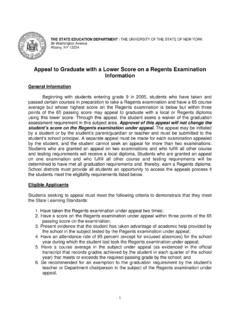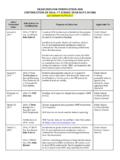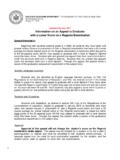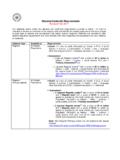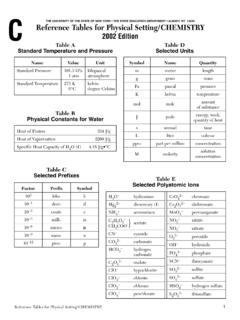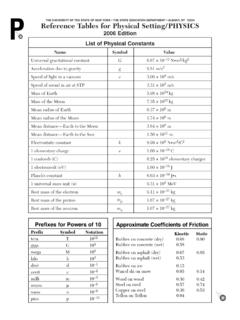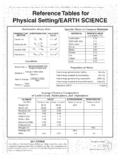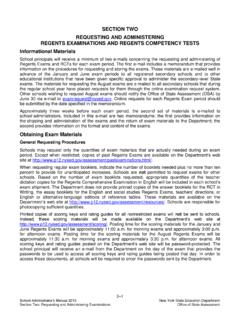Transcription of NYS Grades 3-8 Mathematics Common Core Learning …
1 1 NYS Grades 3-8 Mathematics Common core Learning standards testing Program guidance september -April/May-June Grade 3 CCLS Code Standard Content Emphasis May-June Instructional Periods Operations and Algebraic Thinking Interpret products of whole numbers Major Interpret whole-number quotients of whole numbers Major Use multiplication and division within 100 to solve word problems in situations involving equal groups, arrays, and measurement quantities Major Determine the unknown whole number in a multiplication or division equation relating to three whole numbers Major Apply properties of operations as strategies to multiply and divide Major Understand division as an unknown-factor problem Major Fluently multiply and divide within 100 Major Solve two-step word problems using the four operations.
2 Represent these problems using equations with a letter standing for the unknown quantity. Assess the reasonableness of answers using mental computation and estimation strategies including rounding Major Identify arithmetic patterns and explain them using properties of operations Major Number and Operations in Base Ten Use place value understanding to round whole numbers to the nearest 10 or 100 Additional Fluently add and subtract within 1000 using strategies and algorithms Additional Multiply one-digit whole numbers by multiples of 10 in the range 10-90 using strategies based on place value and properties of operations Additional Number and Operations--Fractions Understand a fraction 1/b as the quantity formed by 1 part when a
3 Whole part is partitioned into b equal parts; understand a fraction a/b as the quantity formed by a parts of size 1/b Major Understand a fraction as a number on the number line; represent fractions on a number line diagram Major Explain equivalence of fractions in special cases and compare fractions by reasoning about their size Major 2 Measurement and Data Tell and write time to the nearest minute and measure the time intervals in minutes. Solve word problems involving addition and subtraction of time intervals in minutes Major Measure and estimate liquid volumes and masses of objects using standard units of grams, kilograms, and liters.
4 Add, subtract, multiply, or divide to solve one-step word problems involving masses or volumes Major Draw a scaled picture graph and a scaled bar graph to represent a data set with several categories. Solve one- and two-step how many more and how many less problems using information presented in scaled bar graphs. Supporting Generate measurement data by measuring using rulers marked with halves and fourths of an inch. Show the data by making a line plot Supporting May-June Recognize area as an attribute of plane figures and understand concepts of area measurement Major Measure areas by counting unit squares Major Relate area to the operations of multiplication and division Major Solve real world and mathematical problems involving perimeters of polygons Additional May-June Geometry Understand that shapes in different categories may share attributes and that the shared attributes can define a larger category.
5 Supporting May-June Partition shapes into parts with equal areas. Express the area of each part as a unit fraction of the whole. Supporting Key to Common core Learning Standard (CCLS) Code: 3 = 3rd Grade OA = Operations and Algebraic Thinking 9 = CCLS number Note: Some standards have lettered components (a, b, ) that help to make up the standard. If a standard is placed in the May-June instructional period, so are all of its lettered components. 3 Grade 4 CCLS Code Standard Content Emphasis May-June Instructional Periods Operations and Algebraic Thinking Interpret a multiplication equation as a comparison. Represent verbal statements of multiplicative comparisons as multiplication equations. Major Multiply or divide to solve word problems involving multiplicative comparison Major Solve multistep word problems posed with whole numbers and having whole-number answers using the four operations, including problems in which remainders must be interpreted.
6 Represent these problems using equations with a letter standing for the unknown quantity. Assess the reasonableness of answers using mental computation and estimation strategies including rounding. Major Find all factor pairs for a whole number in the range 1 100. Recognize that a whole number is a multiple of each of its factors. Determine whether a given whole number in the range 1 100 is a multiple of a given one-digit number. Determine whether a given whole number in the range 1 100 is prime or composite. Supporting Generate a number or shape pattern that follows a given rule. Identify apparent features of the pattern that were not explicit in the rule itself. Additional Number and Operations in Base Ten Recognize that in a multi-digit whole number, a digit in one place represents ten times what it represents in the place to its right Major Read and write multi-digit whole numbers using base-ten numerals, number names, and expanded form.
7 Compare two multi-digit numbers based on meanings of the digits in each place, using >, =, and < Major Use place value understanding to round multi-digit whole numbers to any place. Major Fluently add and subtract multi-digit whole numbers using the standard algorithm Major Multiply a whole number of up to four digits by a one-digit whole number, and multiply two two-digit numbers, using strategies based on place value and the properties of operations. Illustrate and explain the calculation by using equations, rectangular arrays, and/or area models. Major Find whole-number quotients and remainders with up to four-digit dividends and one-digit divisors, using strategies based on place value, the properties of operations, and/or the relationship between Major 4 multiplication and division.
8 Illustrate and explain the calculation by using equations, rectangular arrays, and/or area models. Number and Operations--Fractions Explain why a fraction a/b is equivalent to a fraction (n a)/(n b) by using visual fraction models, with attention to how the number and size of the parts differ even though the two fractions themselves are the same size. Use this principle to recognize and generate equivalent fractions. Major Compare two fractions with different numerators and different denominators. Recognize that comparisons are valid only when the two fractions refer to the same whole. Record the results of comparisons with symbols >, =, or <, and justify the conclusions. Major Understand a fraction a/b with a>1 as a sum of fractions 1/b.
9 Major Apply and extend previous understandings of multiplication to multiply a fraction by a whole number. Major Express a fraction with denominator 10 as an equivalent fraction with denominator 100, and use this technique to add two fractions with respective denominators 10 and 100. Major May-June Use decimal notation for fractions with denominators 10 or 100. Major May-June Compare two decimals to hundredths by reasoning about their size. Recognize that comparisons are only valid when the two decimals refer to the same whole. Record the results of comparisons with the symbols >, =, or < and justify the conclusions Major May-June Measurement and Data Know relative sizes of measurement units within one system of units including km, m, cm, kg, g; lb, oz.
10 ; l, ml; hr, min, sec. Within a single system of measurement, express measurements in a larger unit in terms of a smaller unit. Record measurement equivalents in a two-column table. Supporting May-June Use the four operations to solve word problems involving distances, intervals of time, liquid volumes, masses of objects, and money, including problems involving simple fractions or decimals, and problems that require expressing measurements given in a larger unit in terms of a smaller unit. Represent measurement quantities using diagrams such as number line diagrams that feature a measurement scale. Supporting May-June Apply the area and perimeter formulas for rectangles in real world and mathematical problems Supporting Make a line plot to display a data set of measurements in fractions of a unit.

